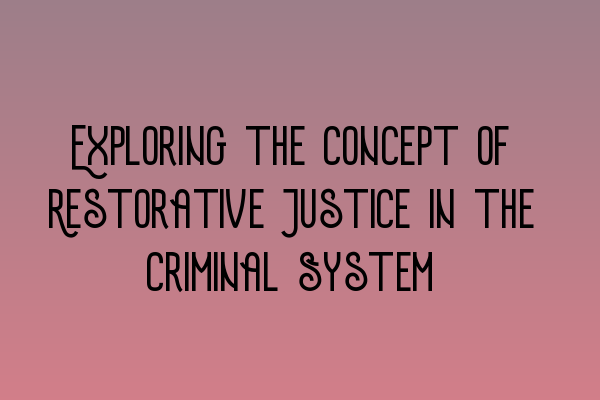Exploring the Concept of Restorative Justice in the Criminal System
In the criminal justice system, traditional punitive measures have long been the norm. However, in recent years, there has been a growing recognition of the potential benefits of restorative justice. This revolutionary concept focuses on repairing the harm caused by a crime and reintegrating all parties involved back into the community.
What is Restorative Justice?
Restorative justice is an alternative approach to criminal justice that emphasizes the importance of healing and reconciliation. The traditional system often focuses solely on punishment, but restorative justice aims to address the underlying issues and help individuals take responsibility for their actions.
Through a restorative justice process, victims, offenders, and communities engage in dialogue and work together to find solutions that provide accountability, promote healing, and prevent future harm. This approach recognizes that crime affects not only the immediate victim but also the offender and the wider community.
Key Principles of Restorative Justice
1. Inclusion and Participation
In a restorative justice process, all parties affected by the crime have the opportunity to participate. This includes the victim, offender, and community members. Their voices and needs are central to the conversation, allowing for a more holistic understanding of the harm caused.
2. Responsibility and Accountability
Restorative justice encourages offenders to take responsibility for their actions and make amends. By actively participating in the process and understanding the impact of their behavior, offenders can develop a sense of accountability and work towards positive changes.
3. Healing and Reconciliation
One of the primary goals of restorative justice is to promote healing and foster reconciliation. By engaging in dialogue and understanding the harm caused, victims and offenders have the opportunity to address their emotional and psychological needs. Ultimately, this can lead to restoration and a sense of closure for all parties involved.
4. Community Involvement
Restorative justice recognizes the importance of involving the community in the process. By engaging community members, the wider impacts of the crime can be addressed, and community support can be mobilized to aid in the offender’s reintegration.
The Benefits of Restorative Justice
Restorative justice offers several advantages over the traditional punitive system. Firstly, it provides victims with a greater sense of agency and empowerment, allowing them to have a voice and actively participate in the resolution process. Additionally, it has been shown to reduce rates of re-offending, as offenders are given the opportunity to understand the consequences of their actions and make amends.
Restorative justice also promotes healing and restoration within communities, as it encourages dialogue and understanding. By involving community members, it fosters a sense of shared responsibility and unity in preventing future crime.
Conclusion
The concept of restorative justice is a valuable and evolving approach within the criminal justice system. By focusing on healing, reconciliation, and community involvement, it offers a more holistic and transformative process for all those affected by crime. To learn more about criminal law practice and SQE preparation, consider exploring our related articles:
- SQE 1 Practice Exam Questions
- SQE 1 Practice Mocks FLK1 FLK2
- SQE 2 Preparation Courses
- SQE 1 Preparation Courses
- SRA SQE Exam Dates
